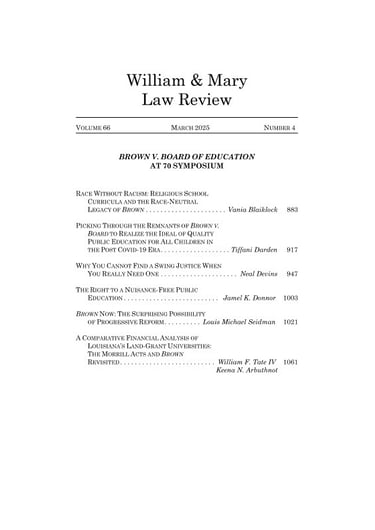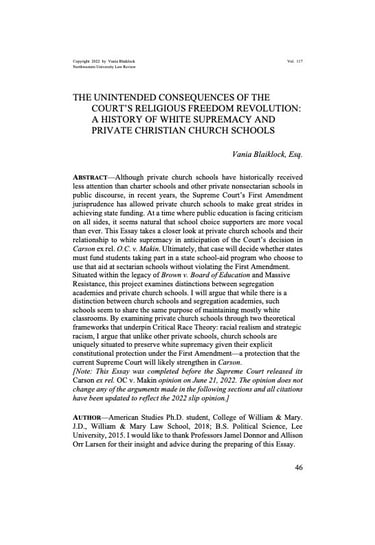Published Works
Explore my contributions to legal history and related publications.


Race without Racism: Religious School Curricula and the Race Neutral Legacy of Brown
William & Mary Law Review (2025)
Abstract:
As a part of William & Mary Law Review’s symposium celebrating the 70th anniversary of Brown v. Board of Education, this essay examines a site of modern resistance to the Brown decision: religious school curricula.
Current conversations about race and equity curricula in primary and secondary education exclude examining religious curricula because of their private classification. Yet, this omission prevents us from exploring how religious curricula might mirror the legal transformation of Brown’s racial equality legacy to constitutional race neutrality. This Article brings religious curricula into these conversations by specifically linking the Court’s race-neutral transformation of Brown to the way religious curricula frame discussions about race without racism. Throughout the Article, I argue that the Court’s transformation of Brown is not just a top-down legal framework but also a bottom-up educational ideology. By making this connection, this Article suggests that religious schools are relevant to the legacy of Brown in the present as well as the past.
A License to Discriminate: The Risky Next Step of Religious Charter Schools
Harvard Law & Policy Review (2024)
Astract:
From 2017 to 2022, the Supreme Court strengthened its First Amendment Free Exercise jurisprudence by deciding that states can provide aid to religious educational institutions through general benefit programs. Six months after the Court’s most recent religious aid case, Carson v. Makin, Oklahoma’s Attorney General stated that he would no longer enforce the nonsectarian provision of the state’s public charter statute because it was unconstitutional under Carson and its progeny. That opinion initiated the application and 2023 approval of the first religious charter school, St. Isidore of Seville Catholic Virtual School by Oklahoma’s Virtual Schoolboard. Immediately, state litigation ensued, and in 2024 the Oklahoma Supreme Court held that the St. Isidore violated state and federal requirements of separation between church and state. The school plans to appeal the decision to the United States Supreme Court.
In preparation for that appeal, this Article examines the legal and policy questions presented by religious charter schools. It argues that Carson does not apply to charter schools as public schools funded directly by the state. Further, the Article argues that even if Carson did apply, the Court should be hesitant to extend constitutionality to religious charter schools because of religious schools’ unique ability to discriminate against LGBTQ+ and disabled students via admissions, employment, and curriculum. Thus, religious charter schools, as the next step in the Court’s religious aid jurisprudence, will have serious implications for not only the Establishment Clause but also for constitutional commitments to equality.


The Unintended Consequences of the Court’s Religious Freedom Revolution: A History White Supremacy and Private Christian Church Schools
Northwestern University Law Review Online (2022)
Abstract:
Although private church schools have historically received less attention than charter schools and other private nonsectarian schools in public discourse, in recent years, the Supreme Court’s First Amendment jurisprudence has allowed private church schools to make great strides in achieving state funding. At a time where public education is facing criticism on all sides, it seems natural that school choice supporters are more vocal than ever. This Essay takes a closer look at private church schools and their relationship to white supremacy in anticipation of the Court’s decision in Carson ex rel. O.C. v. Makin. Ultimately, that case will decide whether states must fund students taking part in a state school-aid program who choose to use that aid at sectarian schools without violating the First Amendment. Situated within the legacy of Brown v. Board of Education and Massive Resistance, this project examines distinctions between segregation academies and private church schools.
I argue that while there is a distinction between church schools and segregation academies, such schools seem to share the same purpose of maintaining mostly white classrooms. By examining private church schools through two theoretical frameworks that underpin Critical Race Theory: racial realism and strategic racism, I argue that unlike other private schools, church schools are uniquely situated to preserve white supremacy given their explicit constitutional protection under the First Amendment—a protection that the current Supreme Court will strengthens in Carson.







